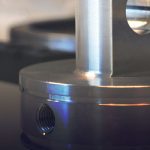To someone who’s never worked in a machine shop, all the equipment looks pretty much the same. But in reality, each machine has a specific purpose. And even two CNC milling machines designed for the same type of job can differ greatly in terms of capabilities.
In this article, I’ll be focusing on the capabilities and benefits of the multi-axis CNC mill, one of the most versatile machines found in a machine shop. Let’s start with a quick background on multi-axis milling.
Multi-axis milling (or multi-axis machining) refers to the use of computer numerically controlled (CNC) tools that move on 4 or more axes to manufacture parts out of metal (or other materials).
Multi-axis machining is a ‘subtractive’ process: used to remove material from a solid piece by milling, water jet cutting, or laser cutting. ‘Typical’ CNC machines are limited to 3 axes, but multi-axis machines surpass that limitation.
In a 3-axis machine, a cutting tool moves while the working piece stays in one place; but in multi-axis machines, both the tool and the working piece can move simultaneously.
While multi-axis machines are more expensive and complex, they offer many benefits:
- Reduced labor: multi-axis machines can turn a piece automatically, while 3-axis CNC machines require a human operator to adjust the position of the piece.
- Improved surface finish: by moving the cutting tool tangentially against the working piece, you can apply a custom finish to any part.
- More complex parts: more degrees of freedom allows you to shape pieces in just about any way (for example, check out this video of a CNC making a mobius strip).
Multi-axis CNC machines are used to make all sorts of high-performance parts, including impellers, turbine blades, and even new cutting tools. They’re particularly useful for producing small, detailed parts. As an example, a major application for them here at Patriot is firearm parts.
OK, but do these complex machines really save time and money?
They do. And to demonstrate how I’ll go deeper into the benefits listed above.
With multi-axis machines, you can use shorter cutting tools. This is possible because the tool can be tilted to adjust the angle at which it meets the part. This might not sound like a big deal, but it actually results in a better surface quality, reduced finishing time, and extended tool life.
It works like this: Shorter tools are more rigid, so they can be operated safely at higher speeds without losing accuracy. This increased cutting speed means parts can be machined faster and surfaces can be finished at higher quality. Tool life is extended because the optimized angle results in a constant chip load and a high-feedrate at the contact point. That last sentence was a mouthful, so I’ll explain.
A constant chip load is a sign of efficient machining. It’s a sign that the tool is being used optimally, with minimal stress applied to it. Chip load is the thickness of the chip coming off the working piece after it has been machined. Every part has an ideal chip load. And if you can stay at the ideal load for the duration of the machining process, you maximize your tool’s effectiveness and lifespan. Incorrect chip loads will lead to overheating and decrease the useful life of your tools.
The feedrate determines the amount of material removed from the working piece. A higher feedrate results in faster machining. If you can get it right, high-feedrate milling increases your productivity and prolongs your tool life.
Feedrate, chip load, and cutting angle are closely related – you need to accurately control all three for optimal performance. And the shorter tools used in multi-axis machines make this a lot easier.
But remember, milling speed is increased in other ways: 4+ axis toolpaths compared to traditional 3 axis toolpaths result in fewer cut passes, which reduces machining time. And because the piece can move independently from the cutting tool, you can machine parts with a single setup, whereas 3-axis machines require multiple manual adjustments of the piece.
This not only speeds up the machining process, but improves quality because any human intervention opens the door for errors.
Our Favorite Multi-Axis Machine: The 4-Axis CNC
When it comes to multi-axis milling, you can get most jobs done with a 4-axis machine. In fact, here at Patriot we use a 4-axis milling machine for most complex jobs, like cutting along an arc. It’s also the easiest machine design to understand.
So let’s dive a little deeper into 4-axis milling.
There are three main job categories for 4-axis milling machines.
1. Indexing
The 4th axis can be set at either indexing or continuous mode. In indexing mode, no machining occurs unless the 4th axis is locked in place. It’s typically used to gain better access inside a complex part. It can also be used for repeated cuts that aren’t continuous, like the teeth on a gear. The machine will index in one position, cut the gear tooth, then move to the next position, index, and cut again.
2. Continuous
In this mode, the 4th axis is free to move with the other 3 axes. As the name suggests, it’s useful for machining continuous parts, like the blade of a turbine. This setting lets you machine some very complex shapes that would be impossible with a 3-axis machine.
3. Wrapping
Sometimes called wrap machining, this is a special case of continuous machining that allows you to perform complex machining on a curved surface. It could be used for engraving text on the side of a cylindrical part, for example. The end result is the same as engraving text on a flat surface then ‘wrapping’ it around the curved part. But with a 4-axis milling machine, you can simply use CAM software to instruct the machine to perform wrapping automatically.
With these advanced capabilities, it’s easy to see how 4-axis milling can be used to produce complex, high-quality parts fast and at a reduced cost.
To sum up, here are the 3 main benefits of multi-axis CNC:
- Automatic turning means you don’t have to stop the machine to adjust the part position
- Varying the cutting angle lets you achieve higher precision and better finishes
- The shorter tools you can use with multi-axis machines last longer and machine faster
Primary keyword: multi-axis milling, 4-axis milling
Secondary keywords: multi-axis machining, 4-axis machining multi-axis CNC, 4-axis CNC, 5-axis milling




